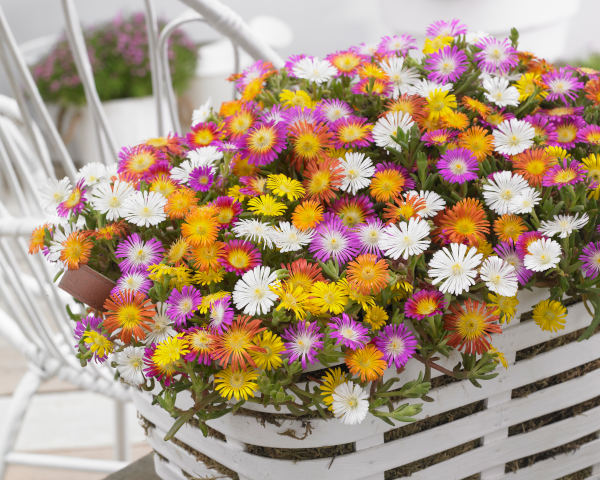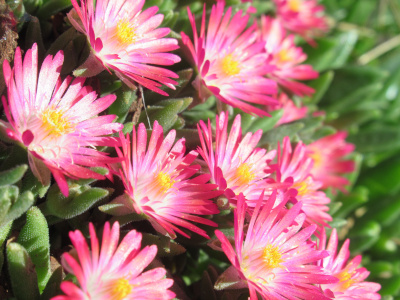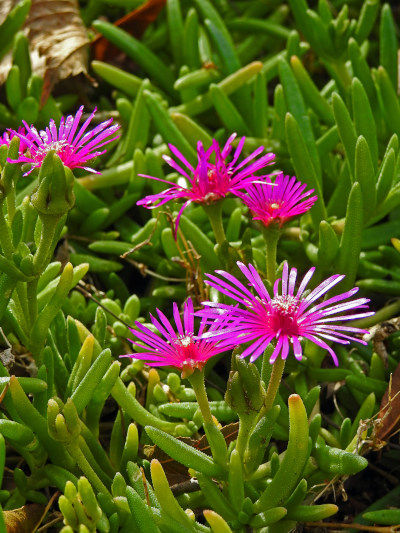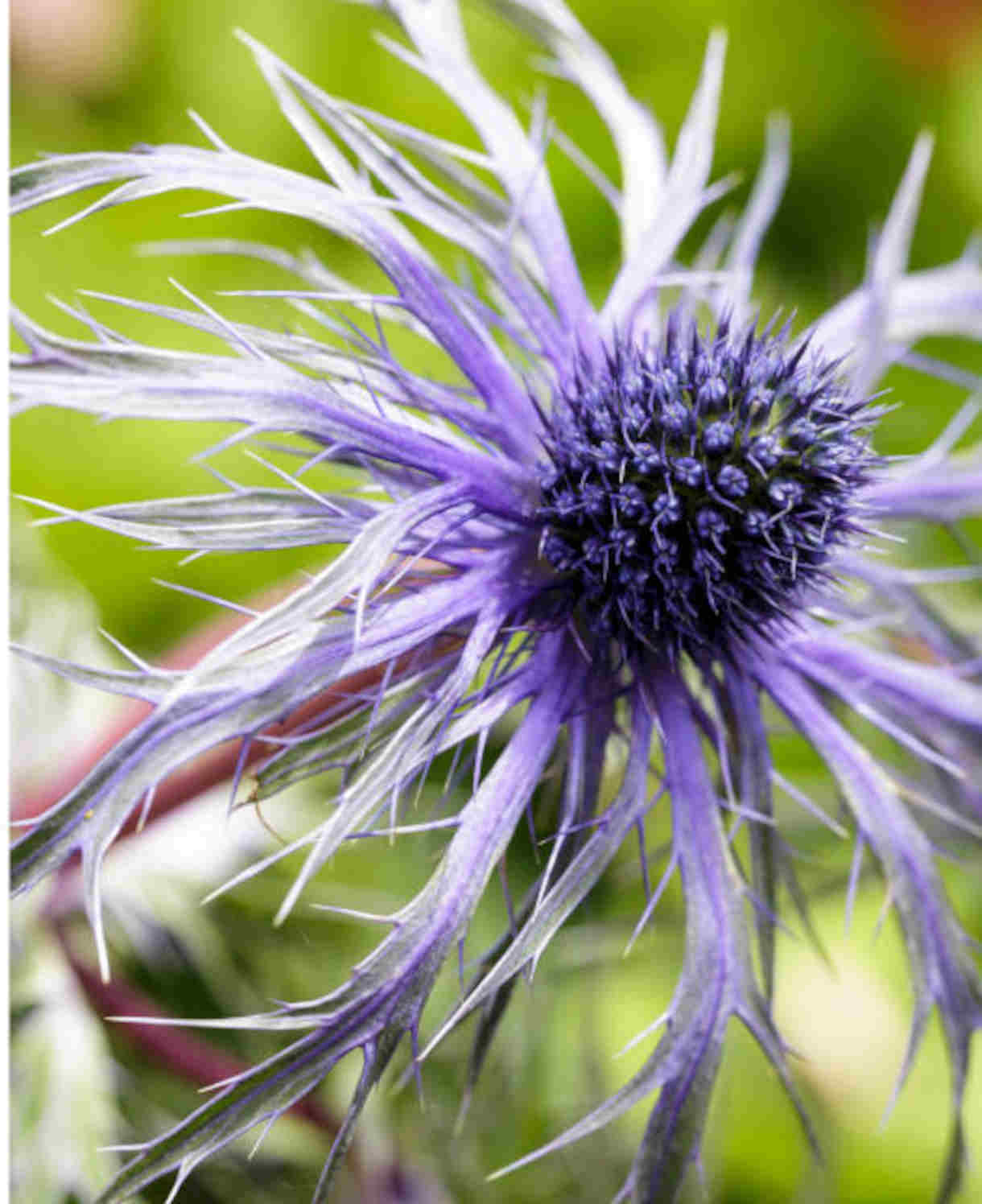How to grow Delosperma
This vigorous, carpet-forming, succulent perennial originates from hilly lowlands throughout central, eastern, and southern Africa, though it is the many cultivated forms in their kaleidoscopic range of colours that can usually be seen growing in our gardens.
Delosperma is also known as ‘ice plant’ due to the tiny glistening crystals covering the flowers and foliage. Its leaves are triangular, finger-esque, and smothered for up to half the year in masses of vibrant, daisy-like blooms. Delosperma is a spectacularly undemanding plant as well as being highly valuable to pollinators.

Key Information
Position- A sunny, sheltered spot
Soil- Very well drained
Flowering Period- Spring until the first frosts
Hardiness- Hardy to between -5°C and -10°C
Position
Soil Conditions
Hardiness


Where & when to plant Delosperma
Our delosperma plants are available from early to mid-spring when they can be planted straight out into the garden, although if supplied as young plants, please follow the instructions included within your parcel.
Delosperma is a tough, drought tolerant succulent able to thrive in tricky, parched spots where others fail. Use it to cover old piles of soil and rubble, sun-baked rockeries, or any sunny spot with poor, gravelly soil. Its fast-growing nature and fine network of roots also makes for useful erosion control on hillsides and slopes. Delosperma is suitable for containers and will happily spill over the edge of a large pot.
How to plant Delosperma
In the ground
- Clear the chosen area of weeds.
- Dig a planting hole several times larger than the root ball. If your soil is at all moist, add plenty of sand or horticultural grit to the planting hole and mix thoroughly. Avoid heavy, clay soil.
- Place the plant in the hole, ensuring the top of the root ball sits level with the surface of the soil. Too low and the plant may rot, too high and the roots can dry out.
- Backfill with soil and firm in gently.
- Soak well with water.
- Mulch around the base with horticultural grit.
In a container
- Choose an appropriate container. The eventual size of delosperma can vary considerably, so do check individual descriptions for details. Ensure there are plenty of drainage holes in the bottom.
- For best results use a compost specifically for cacti and succulents, which contains just the right levels of drainage and nutrients. Alternatively, mix plenty of horticultural grit into any good quality potting compost.
- Start by partially filling the pot with compost; enough so that when placed on it the upper surface of the root ball is about 3cm lower than the top of the pot.
- Infill all the space surrounding the root ball with compost, firming down with your fingers then adding a little more so the plant is held tight.
- Pick up the pot (if you can!) and lightly tap on the potting bench or ground a few times to help further settle the compost around the plant.
- Soak well with water.
- A mulch with horticultural grit will look attractive and help to prevent a ‘cap’ or crust forming on the top of the compost (something container plants can suffer due to the artificial nature of their watering).

What to plant with Delosperma
For a spectacular, ‘dry garden’ display, combine delosperma with other particularly drought-tolerant plants such as cistus, gaillardia, osteospermum, verbascum, eryngium, and one of our favourite recent discoveries, Delphinium nudicaule ‘Laurin’.



How to care for Delosperma
Pruning and Deadheading
None required.
Watering
Water delosperma until established, after which it tends to look after itself.
If growing in a container, water moderately during the growing season. This means allowing the compost to dry out almost completely between soakings.
Cold Protection
The biggest problem for delosperma over winter is not low temperatures as you may expect, but excess water. In very free-draining conditions it can withstand temperatures down to -10°C, however when sitting in damp soil it becomes considerably less hardy.
The best defence is to choose a planting spot carefully. If you do have any concerns about moisture levels, protect your plant over winter with a dry mulch of straw or bracken. If you can, err on the side of caution by moving container grown plants into an unheated conservatory, greenhouse, or cold frame.
Pests and Diseases
Delosperma tends to be relatively pest and disease free, though during warmer weather can find itself host to aphid populations.
Aphids are part of a balanced garden ecosystem and the best approach is to leave them to their natural predators (e.g. birds, ladybirds, and wasps). When numbers are so large, however, that their feeding starts to inhibit and disfigure growth, you may feel it necessary to take additional action. Regularly blasting off with a hose or wiping away with a cloth or piece of kitchen paper can help to keep numbers down without harming other members of the ecosystem.
How to propagate Delosperma
The quickest and easiest way to propagate delosperma is by taking stem cuttings, which can be done anytime during the growing season.
- Find non-flowering shoots 7-12cm long and snip off the plant.
- Remove the leaves from the lowest third.
- Leave the cuttings on a windowsill until the cut ends callous over (which can take anything from 12 hours to three days). This is to avoid rotting when the cutting is sitting in the compost.
- Fill a container with a cactus and succulent compost.
- Insert the cuttings into the compost and water lightly. Several cuttings can be put in the same container if there is enough space to do this without them touching.
- Place on a warm windowsill, preferably out of direct sunlight.
- Keep an eye on the cuttings and water when the compost feels very dry. You can expect for them to have rooted within four to six weeks.
- Gently remove rooted cuttings and pot them into individual pots. Overwinter in a cool yet frost-free environment such as an unheated conservatory, greenhouse, or cold frame, before planting out in late spring.
Common Delosperma questions
- Is delosperma a perennial?
Yes, delosperma is an evergreen perennial. When grown at the limit of its hardiness it may become semi-evergreen, i.e shed some or all of its leaves for a short period during the coldest part of winter. - Is delosperma invasive?
Though quick to grow (often doubling in size during the first year), delosperma is very easily controlled with simple pruning. Its rumoured invasiveness probably comes from confusion with another genus also commonly known as ‘ice plant’ – carpobrotus. Though similar in appearance, this has a far more vigorous and invasive nature, colonising huge swathes of (mainly coastal) areas in many parts of the world. - Can you grow delosperma in pots?
Delosperma makes a wonderful addition to container displays, whether mixed with other succulents such as aeonium and sempervivum, or other long-flowering favourites like argyranthemum, diascia, and pelargonium.




